Pablo Ramirez-Espinosa
On Models with Power Conservation in Reflective Intelligent Surfaces and their Design Implications
Dec 06, 2024



Abstract:Reconfigurable intelligent surfaces (RISs) are potential enablers of future wireless communications and sensing applications and use-cases. The RIS is envisioned as a dynamically controllable surface that is capable of transforming impinging electromagnetic waves in terms of angles and polarization. Many models has been proposed to predict the wave-transformation capabilities of potential RISs, where power conservation is ensured by enforcing that the scattered power equals the power impinging upon the aperture of the RIS, without considering whether the scattered field adds coherently of destructively with the source field. In effect, this means that power is not conserved, as elaborated in this paper. With the goal of investigating the implications of global and local power conservation in RISs, work considers a single-layer metasurface based RIS. A complete end-to-end communications channel is given through polarizability modeling and conditions for power conservation and channel reciprocity are derived. The implications of the power conservation conditions upon the end-to-end communications channel is analyzed.
A New Spatial Block-Correlation Model for Fluid Antenna Systems
Jan 15, 2024Abstract:Powered by position-flexible antennas, the emerging fluid antenna system (FAS) technology postulates as a key enabler for massive connectivity in 6G networks. The free movement of antenna elements enables the opportunistic minimization of interference, allowing several users to share the same radio channel without the need of precoding. However, the true potential of FAS is still unknown due to the extremely high spatial correlation of the wireless channel between very close-by antenna positions. To unveil the multiplexing capabilities of FAS, proper (simple yet accurate) modeling of the spatial correlation is prominently needed. Realistic classical models such as Jakes' are prohibitively complex, rendering intractable analyses, while state-of-the-art approximations often are too simplistic and poorly accurate. Aiming to fill this gap, we here propose a general framework to approximate spatial correlation by block-diagonal matrices, motivated by the well-known block fading assumption and by statistical results on large correlation matrices. The proposed block-correlation model makes the performance analysis possible, and tightly approximates the results obtained with realistic models (Jakes' and Clarke's). Our framework is leveraged to analyze fluid antenna multiple access (FAMA) systems, evaluating their performance for both one- and two-dimensional fluid antennas.
Electromagnetic Based Communication Model for Dynamic Metasurface Antennas
Dec 22, 2022



Abstract:Dynamic metasurface antennas (DMAs) arise as a promising technology in the field of massive multiple-input multiple-output (mMIMO) systems, offering the possibility of integrating a large number of antennas in a limited -- and potentially large -- aperture while keeping the required number of radio-frequency (RF) chains under control. Although envisioned as practical realizations of mMIMO systems, DMAs represent a new paradigm in the design of signal processing techniques (such as beamforming) due to the constraints inherent to their physical implementation, for which no complete models are available yet. In this work, we propose a complete and electromagnetic-compliant narrowband communication model for a generic DMA based system. Specifically, the model accounts for: i) the wave propagation and reflections throughout the waveguides that feed the antenna elements, ii) the mutual coupling both through the air and the waveguides, and iii) the insertion losses. Also, we integrate the electromagnetic model in the conventional digital communication model, providing a complete and useful framework to design and characterize the performance of these systems. Finally, the accuracy of the model is verified through full-wave simulations.
Statistics of the Effective Massive MIMO Channel in Correlated Rician Fading
Dec 13, 2021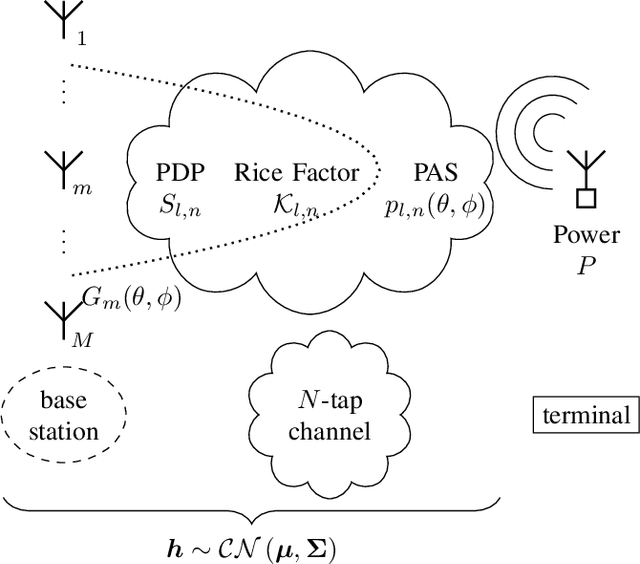
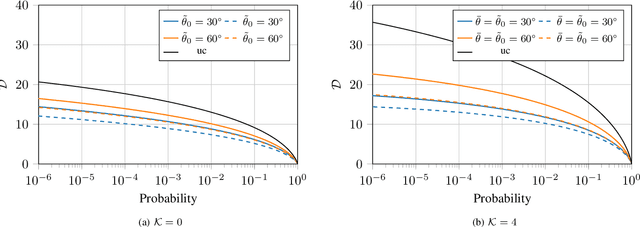
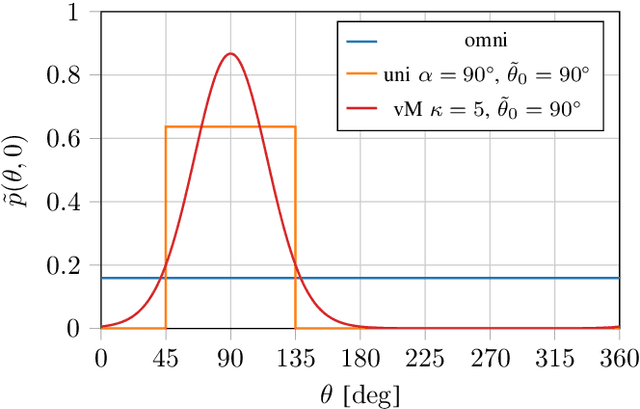
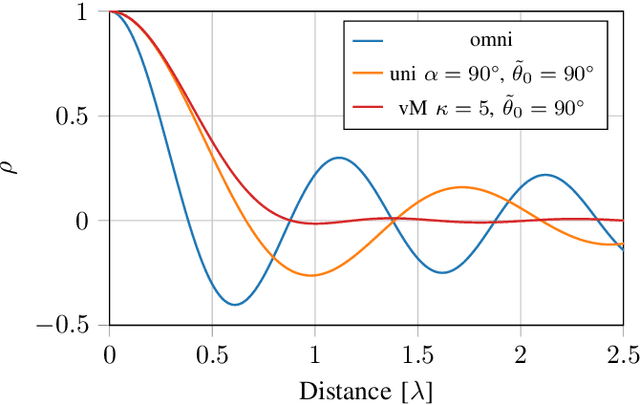
Abstract:Massive MIMO base stations use multiple spatial diversity branches, which are often assumed to be uncorrelated in theoretical work. Correlated branches are considered seldom since they are mathematically less tractable. For correlated Rician fading, only the first- and second-order moments have been explored. To describe propagation environments more accurately, full distribution functions are needed. This manuscript provides these functions for the maximum ratio combining effective channel, a quadratic form of a random complex normal channel vector. Its mean vector and covariance matrix are based on a plane wave model incorporating array geometry, antenna element pattern, power angular spectra and power delay profiles. Closed-form approximations of the distribution functions are presented, to allow the fast evaluation of many real-world scenarios. The statistical framework is used to show that low-directivity antenna elements provide better performance in angular constricted Rician fading with off-axis incidence than high-directivity elements. Moreover, two base station array layouts are compared, showing that a half-circle array illuminates a cell more evenly than a uniform linear array. With the full distribution functions available, performance can be compared over the full range of received powers and not only based on the average SNR.
Radio Sensing with Large Intelligent Surface for 6G
Nov 04, 2021



Abstract:This paper leverages the potential of Large Intelligent Surface (LIS) for radio sensing in 6G wireless networks. Major research has been undergone about its communication capabilities but it can be exploited as a formidable tool for radio sensing. By taking advantage of arbitrary communication signals occurring in the scenario, we apply a Matched Filtering (MF) processing to the output signal from the LIS to obtain a radio map that describes the physical presence of passive devices (scatterers, humans) which act as virtual sources due to the communication signal reflections. We then assess the usage of machine learning (k-means clustering), image processing and computer vision (template matching and component labeling) to extract meaningful information from these radio maps. As an exemplary use case, we evaluate this method for both active and passive user detection in an indoor setting. The results show that the presented method has high application potential as we are able to detect around 98% of humans passively and 100% active users by just using communication signals of commodity devices even in quite unfavorable Signal-to-Noise Ratio (SNR) conditions.
Assessing Wireless Sensing Potential with Large Intelligent Surfaces
Nov 16, 2020



Abstract:Sensing capability is one of the most highlighted new feature of future 6G wireless networks. This paper addresses the sensing potential of Large Intelligent Surfaces (LIS) in an exemplary Industry 4.0 scenario. Besides the attention received by LIS in terms of communication aspects, it can offer a high-resolution rendering of the propagation environment. This is because, in an indoor setting, it can be placed in proximity to the sensed phenomena, while the high resolution is offered by densely spaced tiny antennas deployed over a large area. By treating an LIS as a radio image of the environment relying on the received signal power, we develop techniques to sense the environment, by leveraging the tools of image processing and machine learning. Once a holographic image is obtained, a Denoising Autoencoder (DAE) network can be used for constructing a super-resolution image leading to sensing advantages not available in traditional sensing systems. Also, we derive a statistical test based on the Generalized Likelihood Ratio (GLRT) as a benchmark for the machine learning solution. We test these methods for a scenario where we need to detect whether an industrial robot deviates from a predefined route. The results show that the LIS-based sensing offers high precision and has a high application potential in indoor industrial environments.
A Primer on Large Intelligent Surface for Wireless Sensing in an Industrial Setting
Jun 11, 2020
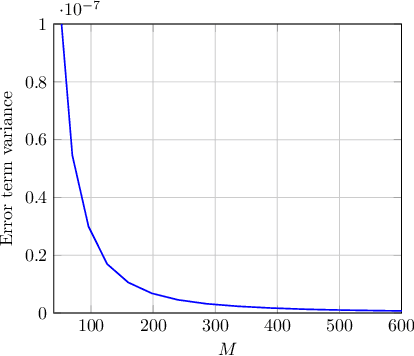


Abstract:One of the beyond-5G developments that is often highlighted is the integration of wireless communication and radio sensing. This paper addresses the potential of communication-sensing integration of Large Intelligent Surfaces (LIS) in an exemplary Industry 4.0 scenario. Besides the potential for high throughput and efficient multiplexing of wireless links, a LIS can offer a high-resolution rendering of the propagation environment. This is because, in an indoor setting, it can be placed in proximity to the sensed phenomena, while the high resolution is offered by densely spaced tiny antennas deployed over a large area. By treating a LIS as a radio image of the environment, we develop sensing techniques that leverage the tools of image processing and computer vision combined with machine learning. We test these methods for a scenario where we need to detect whether an industrial robot deviates from a predefined route. The results show that the LIS-based sensing offers high precision and has a high application potential in indoor industrial environments.
 Add to Chrome
Add to Chrome Add to Firefox
Add to Firefox Add to Edge
Add to Edge